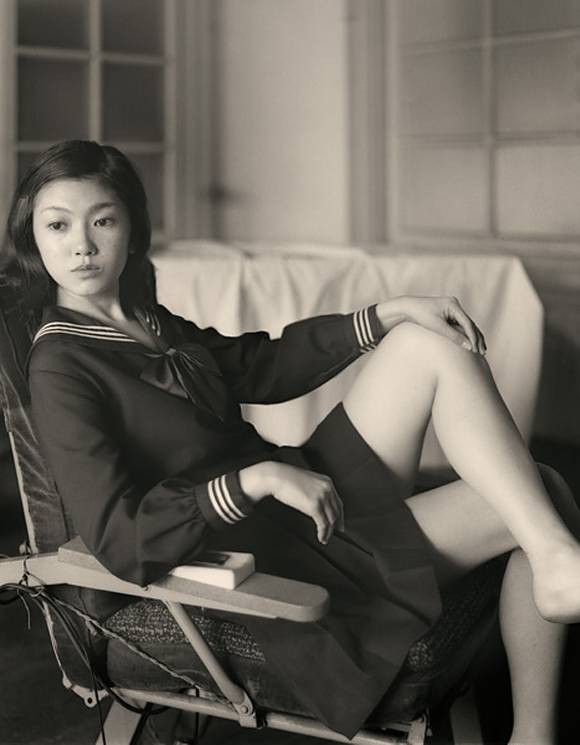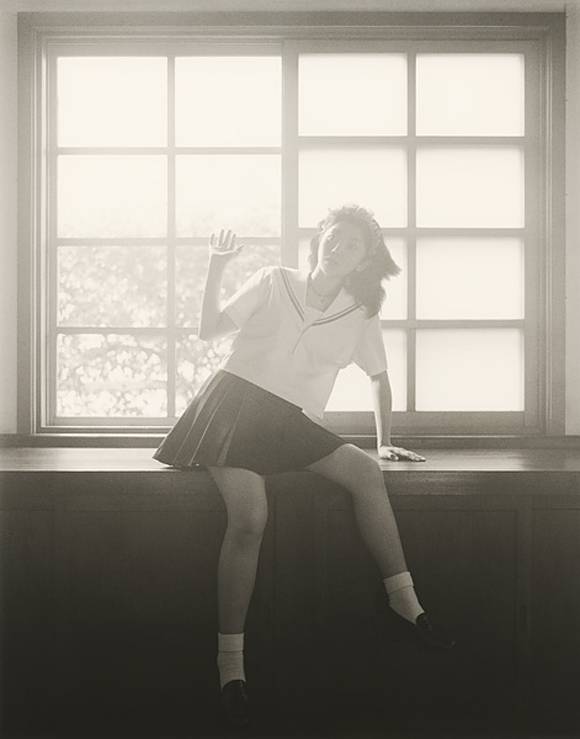Interview with Japanese Artist Hisaji Hara
3 13 Share TweetHisaji Hara is a Japanese artist who’s known for his photographic works. “A Photographic Portrayal of the Paintings of Balthus” is his magnum opus and recreates the paintings of revered Polish-French painter, Balthus but also contains something so very unique that you’ll appreciate them standing separate from their Balthus counterparts. After the jump, discover what his vision entails in our interview!

Name Hisaji Hara (原久路)
Field Artist
Location Tokyo, Japan
1. Your featured photographs highlight recognizable “characters” from contemporary Japanese society, namely the “schoolgirl”. Why’s this?
Because in my series "a Photographic Portrayal of the Paintings of Balthus, the images of the “schoolgirl” as an icon of Japanese contemporary culture acted in the role of a metaphor, of crossing over the boundary between the two cultures — the East and West.
As Balthus said that every “work” must be universal, his original paintings represented the metaphor of crossing over between different cultures. Some of them look like old Chinese landscape paintings, or like traditional Japanese genre paintings, despite the fact they actually look like direct descendants of European Renaissance paintings. I tried to trace the cultural diversity of Balthus’ paintings through applying the character of the “schoolgirl” to accurate postures of his paintings in my photographic productions.

2. Would you say, black and white is your go-to film format?
Yes, I would say so. But it is not for expressing a nostalgic feeling. I photographed my Balthus series with analog black and white films. But the final prints in the series are digital pigment prints. They were printed in black and white, but their sepia-tones are slightly different from each other to replicate the aging of silver nitrate.
By using such a method, I tried to free my series from the clichéd concept of “new” or “old”.
If they were printed in full-color, viewers would be able to recognize them with the impression that “they aren’t so old” as they were photographed at some particular point during the latter part of the history of photography. However, if they were printed in sepia-toned black and white with digital, viewers would likely never be able to specify the time when the pictures were photographed. So I think that the images, printed in such way, can enjoy the diversity of time. (In addition to digital pigment prints, I am utilizing the classical albumen method from the 19th century to print the series. Through adding this method, I’m trying to make my series more free from the history of photography. By showing digital and albumen prints simultaneously, I hope that it can allow viewers to overcome the difference of materials and to see the image itself for what it is.
The importance of seeing an image itself without depending on its materials is that it can free our imagination from the limited history of materials/techniques and connect it directly to the longer history of broader visual expression including cave paintings from approximately thirty thousand years ago.)
3. Your formal training is in videography and you’ve been the director of photography for numerous films – when you shoot still photographs is it more similar or different to your approach with the video medium?
Technically, it’s similar. I use the techniques commonly used in movie making at the shooting site of my series. I used a huge smoke machine to produce an aerial perspective effect by controlling the thickness of artificial fog for instance. Multiple exposures used in the series is another example. I used multiple exposures to show two girls, played by the same model, in one frame simultaneously. I came up with this idea from some basic sci-fi movie techniques. But there is a big difference between movie and photography. The difference of “time flow”.
In a movie, time flows in proportion. A movie can be produced by sculpting in time with different lengths of sequences. Its structure is more similar to that of music. But a photograph must be structured using only one segment of time. In a photograph, time can never be proportional because there is no actual time flow. You can merely apply a solid homogeneous conception of time to a photograph. That is more similar to time perceived when listening to a siren blowing in the distance than in a musical sequence.
4. The “still life” studies, of the fruit, could be from any time and place and follow in the long tradition of “still life” over the centuries. Nowadays, with so many people photographing their plates of food in restaurants, has the value of a “still life” decreased?
I do not think so. It’s more like the opposite. I think that the value of the “still life” can be increased by people photographing their plates of food in restaurants because the most basic definition of “still life” is that it is not a “portrait” or “landscape”. People photographing their plates are not taking photos of their friends, beloved family, or breathtaking landscapes, but are taking their “still life”!
I have found this truth from seeing my friends taking photos of their plates. They never forget to photograph their plates before they start eating despite their hunger. It always reminds me that traditional, serious, painters never forgot to sketch everyday incidents even if they forgot to have lunch.
5. What inspired you to compose a series of photos based on the paintings by Balthus?
When I studied painting as a school boy, I was interested in traditional paintings and encountered Balthus’ paintings around that time. But after entering an Art University in the early 1980s, my interests shifted to contemporary art and I forgot Balthus for almost twenty years. However, it was a cozy autumn evening of 2005, when I was fast asleep, that an image of Balthus’ work suddenly came back to my mind. Since it was all of a sudden, I couldn’t trace the reason as to “why” it happened. I could only guess that it was the time to change the meaning of Contemporary Art inside of me. That is to say, “my Contemporary Art” had stopped to be contemporaneous, since that night, and started to be connected to our long history of Art. In other words, it had stopped trying to be “new” or “individual” and started pursuing the route of universality.
Since Balthus is not only the contemporaneous of my time but also the true successor of our tradition, the painter became the perfect example of my newly defined Contemporary Art.
So my series “a Photographic Portrayal of the Paintings of Balthus” is one of my photographic studies (Photography being my technique, and Painting Balthus’) to explore the universality in his paintings which transcends time.
6. Do you shoot in analogue (film) or digital nowadays? Why do you prefer your chosen medium?
When I took the Balthus series in 2006, I used medium and large format analog film cameras since digital cameras were not yet good enough to produce high definition images. I started using digital cameras since the beginning of 2009 and am using it without any dissatisfaction nowadays.
In the production of the Balthus series in 2006, I had no choice but to utilize the physical multiple exposure method at the site of the photo shoot. It was by putting a huge matte box on the end of a camera lens and covering it with a set of two black mask sheets, one by one, that I managed to expose the film’s surface separately, part by part. Now I can choose more adapted ways to produce the same effect from either the analog or digital method. So I can say that my preferences regarding the analog or digital medium depends on the results I aim to produce.
7. Which are your most precious film-photography cameras?
PENTAX 67 medium format SLR series and the Linhof Technika large format field camera series
8. What is one thing (subject/location etc.) you wish to photograph in the future?
I would like to photograph old-fashioned public facilities like closed schools which can represent our former modernity.
From my individual viewpoint, those facilities seem to reflect the destiny of photography as if it were a son of our industrial modernity which is now being absorbed by the longer history of comprehensive visual expressions like painting.
9. What are you currently working on at the moment (if it’s a secret, then fill us in with as much as you can provide)?
I am currently working on my next project which is portraying some classic paintings through digital photography. Unfortunately, I cannot disclose the name of the original painters to the public yet since the new project is still under preparation.
Please look forward to seeing the new results!
10. For our photography enthusiasts who are just starting out, with your expertise and experience, what are some words of wisdom you can provide them?
Photography is not a servant of photography. Photography is a missionary of something broader than photography.
written by soundfoodaround on 2012-09-21 #tokyo #lifestyle #black-and-white #artist #photographer #japan #videographer #hisaji-hara #balthus #stil-life #albumen








































3 Comments